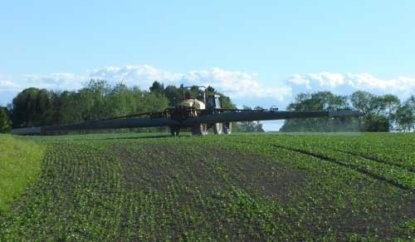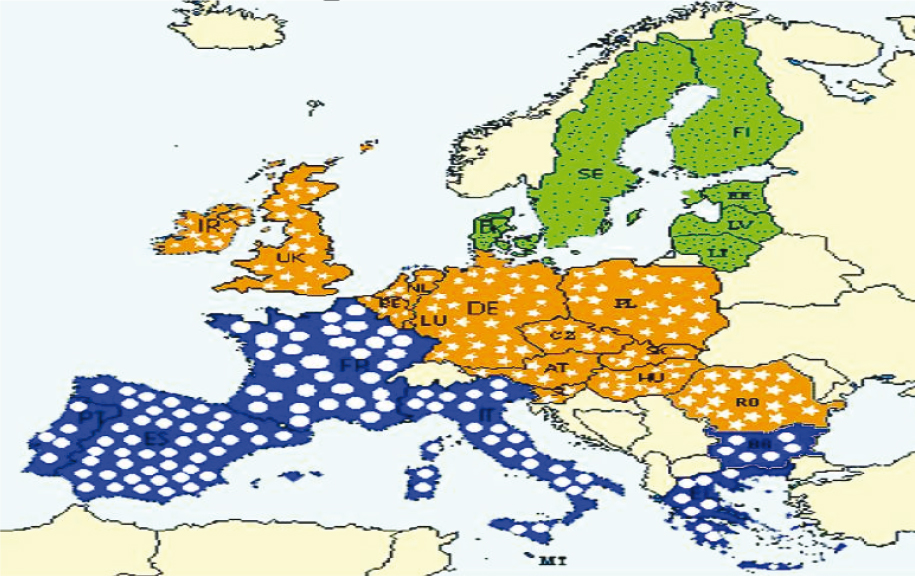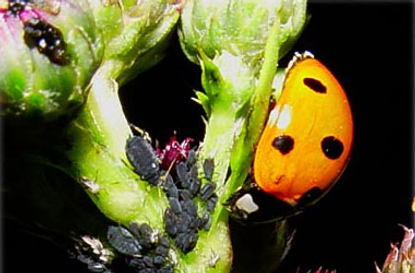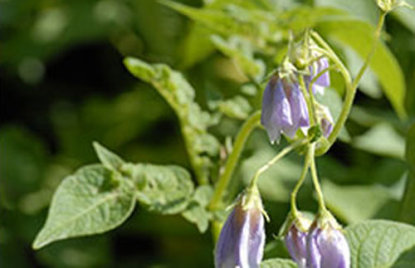Contact
Mikaela Gönczi, Director
SLU Centre for Pesticides in the Environment
mikaela.gonczi@slu.se, +46 18-67 31 05

Pesticides are used to control organisms that can cause damage or impairment to human health or property.
These harmful organisms can be animals (for example insects or rodents), plants (weeds) or microorganisms (mould fungi, bacteria or viruses) that can cause damage e.g. by destroying crops and property or by spreading and causing disease. However, the use of pesticides is also associated with risks to the environment and health. For a pesticide to be sold and used in Sweden, it must be approved by the Swedish Chemicals Agency (KemI). KemI assesses the risks it poses both to human health and the environment. The products assessed as being acceptable are approved for a maximum period of 10 years.
The feature shared by all pesticides is that they are products specially designed to affect (kill, inhibit growth or otherwise control the numbers of) living organisms that are perceived as pests.
Chemical control products are divided into plant protection products, which are used to protect plants within agriculture, forestry and horticulture, and biocidal products (e.g. timber impregnation products, boat keel paints and slime control products) according to two EU directives. Plant protection chemicals can in turn be subdivided according to area of use: herbicides for weeds, fungicides for fungi and insecticides for insects. The term ‘pesticides’ is generally used synonymously with plant protection products, but is now often taken to include biocidal products too.
According to statistics from the Swedish Chemicals Agency, in 2017 a total of 9.243 tonnes of chemical pesticides (calculated as active ingredient) were sold in Sweden. This was a decrease of 522 tonnes compared with the previous year. The vast majority (77%) went to industry in the first instance, for pressure and vacuum impregnation of timber. Sales to agriculture, including fruit and horticultural production, decreased in 2017 by 86 tonnes to 1.532 tonnes, and now comprises around 17% of total sales. The most common chemical pesticides sold are herbicides, followed by fungicides, insecticides and seed dips.
Pesticides are used to control organisms that can cause damage or impairment to human health or property. Plant protection products are pesticides used mainly within agriculture to protect crops from attacks by fungi, insects and weeds. When these attack crops, the results can be devastating. In extreme cases the entire crop may be lost. Since the 1940s and 1950s, chemical pesticides have contributed to an considerable increase in global food production through higher yields and, not least, more reliable cropping. Chemical pesticides are still important within agriculture. At the same time, alternative methods are being developed, for example use of varieties that are resistant to fungal and insect attack without the use of chemicals.
With current knowledge, it is not possible to completely exclude the use of chemicals from crop production if yields are to be maintained, or to apply techniques that completely prevent the spread and environmental impacts of the compounds used. However, in a longer-term perspective (a generation), society is endeavouring to achieve fundamental change by moving away from the dependence on chemicals that characterises modern crop production. The Swedish environmental quality objective ‘a non-toxic environment’ states e.g. that to achieve the objective, the concentrations of non-naturally occurring substances will be close to zero and their impacts on human health and on ecosystems will be negligible. This will require efforts to develop and implement alternatives to chemical pest control.
The EU sets the framework for the regulations concerning pesticides in its member countries. For pesticides, regulation (EC) 1107/2009 on the use of plant protection products applies. It regulates e.g. the products which may be sold and used within the EU. The regulations aim to minimise the environmental and health risks, but also to remove barriers to trade in pesticides between countries. The EU body for food security, EFSA, carries out risk assessments during pre-approval testing of active compounds. A major review of all pesticides 1998-2009 resulted in only one-quarter of the existing compounds within the EU having their approved status confirmed.
Since 2011, harmonisation of the pesticides used in the EU member countries has been underway. The EU is divided into three zones for this purpose, with Sweden allocated to the northern zone together with Denmark, Finland, Estonia, Latvia and Lithuania. New products are tested by one country in each zone and approval applies for all countries within that zone. For existing products, the parties involved can apply for mutual recognition to sell a product that is approved in another country within the zone.

The EU’s three zones for registration of pesticides. Sweden belongs to the northern zone. Source: Swedish Chemicals Agency.
2009 saw the release of an EU framework directive, 2009/128/EC, for the sustainable use of pesticides. The directive aims to achieve sustainable use of pesticides by minimising the risks and consequences that the use of pesticides brings for human health and the environment. This is achieved through common regulations on the use of pesticides, for example function tests on agricultural sprayers should be compulsory. In Sweden, these tests are currently voluntary. An important part of the sustainability directive is that from 2014, so-called integrated pest management (IPM) must be applied. This means that preventative and non-chemical methods must be used in the first instance. The aim with this is to decrease the amount of chemical plant protection products used. All countries must produce an action plan for the sustainable use of plant protection products. Responsibility for the Swedish action plan lies with the Swedish Board of Agriculture.
The term pesticide generally refers to a natural or synthetic chemical substance or mixture of substances. The compound or compounds that have a controlling effect on the pest are usually referred to as the 'active ingredient'. Various types of compounds are added to the active ingredient to help in application and spraying. These may include solvents or emulsifying ingredients.
There are also biological ‘pesticides’. Biological control is a method for limiting the effects of harmful animals, pathogens and plants by using other, beneficial organisms, e.g. microorganisms, insects and plants that inhibit the harmful organisms.
This is a method that benefits from fundamental ecological interactions between organisms, such as predation, parasitism, pathogenicity and competition. Biological control is currently used primarily to combat pests in plant production.

Figure. The seven-spot ladybird is a species of beetle belonging to the family Coccinellidae. It is used in biological control, of aphids in particular. Both the larvae and the adult beetle eat aphids. Photo: Börge Pettersson, SLU.
A plant protection area in which alternative methods have made progress is seed dipping to prevent fungal attack. The use of chemical dips has decreased in recent years and these are being replaced to some extent today by bacterial products or by heat treatment.
The pesticides are sometimes grouped according to the way in which they act, i.e. their biological mechanism of action. Foliar pesticides are taken up by leaves or green plant parts. Soil-acting pesticides are intended to act via the soil on growing seeds, shoots or roots. Contact pesticides affect those parts of a weed or pest that are directly touched by the spray liquid. Systemic pesticides affect the entire target organism (weed or insect) through the active ingredient being transported in the plant’s vascular system following uptake by the roots or other plant parts treated with the compound. This ensures that the pesticide reaches all parts of the plant. For example, systemically acting seed dips reach the entire plant as it develops, i.e. long after the time of treatment.

In Sweden there are around 100 different potato cultivars that are grown commercially and all are more or less susceptible to pest attack, particularly by various fungal blights. Potatoes can also be attacked by viruses and nematodes. Photo: Ragnhild Möller, SLU.
Mikaela Gönczi, Director
SLU Centre for Pesticides in the Environment
mikaela.gonczi@slu.se, +46 18-67 31 05